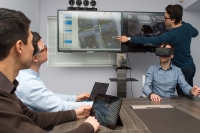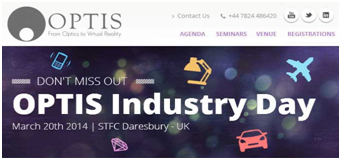 |
|||||
Home > News > Members and Partners News > OPTIS

Credits Brigitte Wavrant
SPEOS is now HPC and VR-ready for enhanced design capabilities
OPTIS, pioneer and global provider of lighting simulation solutions for industries, announces the latest version of SPEOS. OPTIS’ flagship software is the only CAD simulation software available to solve the technical challenges of lighting, color and materials within CAD environments. With this latest release, SPEOS is also HPC and VR-ready, providing a realistic product experience, very quickly.
SPEOS 2017 delivers faster calculation with its HPC declination: SPEOS users can now get the results of their simulations a 1000 times faster. SPEOS’ renderings and analyses, used to make key decisions in organizations, can now be processed quickly via HPC to get a result in a time frame that matches the business. This « click and go » option distributes SPEOS computation on several computers using on premises or off premises clusters. SPEOS HPC revolutionizes the optical and light design, which now benefits from instantaneous virtual prototyping means. Now, SPEOS HPC makes timely, high quality results, a reality. The smart engineering practice for customers with HPC is to address the volume of simulations and to validate more possibilities.
Until now, SPEOS visualizations were limited to very precise 2D images. With SPEOS 2017, the physical realism of the images generated by the software is now available in 3D. This connection to Virtual Reality allows to explore a SPEOS 3D result in high resolution, in real time, in a CAVE or with a VR helmet. A set of innovative features allows the 3D manipulation of the virtual model to test several configurations. Users can move around the scene, interact with the product and the environment, turn lights on and off, modulate them and instantly see the impact of their modifications on the product. "We have been working on an immersion in the virtual prototype, that would guarantee the same image quality that SPEOS already offers. After a year, SPEOS is now a collaborative laboratory facilitating the decision-making process within organizations,” says Nicolas Orand, Director of Product Development at OPTIS.
SPEOS 2017 now integrates dedicated engineering tools such as Head-Up Displays (HUD) to allow automotive and aerospace manufacturers to design more innovative and powerful systems with a few clicks. SPEOS 2017 also makes it possible to precisely measure luminance, at the very heart of the virtual product, even in places that would be hard to access to on a physical prototype. Users can thus perfectly understand the behavior of the light in a system and better optimize it. SPEOS 2017 also brings an increased realism to the visualization of materials. The goal is to facilitate design innovation: it is now possible to group several optical and geometric properties into a single item, in order to recreate easily all the subtle variations of a complex material under any lighting.
To solve major trends in automotive innovation and help manufacturers to reduce their times to market, SPEOS 2017 provides three new features:
-
Automated design of lighting systems: no need to be an expert in optical design, headlights optics can now be created with a click, in an infinite variations of designs.
-
Simulation of augmented reality systems, in particular for future head-up displays (HUDs), which project information on windshields.
-
Simulation of MOEMS (micro-optical components for light projection systems). These components are now being introduced in HUD projectors, and are being evaluated in future "matrix-beam" headlights: it is no longer a question of projecting a beam of inert light onto the road but of having an intelligent headlight, which will display a video on the road that will allow to see and to signal, by projection, the presence of any danger for example.
| September 13th, 2016. - SPEOS HPC, the newest arrival of the OPTIS offer, permits to deploy the company’s solutions and get high quality simulation in almost real time. Watchwords for this progress: Rapidity, efficiency and new possibilities due to High Performance Computing! OPTIS, the world-renowned editor in the simulation of optics, light and human vision announces that SPEOS HPC, a new product of its range, is available since June. OPTIS launches SPEOS HPC, a new version of its award-winning solution SPEOS, providing simulations’ “ We wanted to improve our offer and give the opportunity to any OPTIS’ users, to win time and preview With that in mind, the OPTIS developer team has worked in order to allow rapidity, efficiency and “Thanks to this innovation, working with SPEOS is now really comfortable, and it should make the use much The company’s latest customer to date is Volvo, which has evolved from 4 000 to 10 000 cores in a record OPTIS already announces that all the range of its products will be available in HPC version, soon! |
February 21, 2014 : A day during which all sectors industrial combined will share their experience around the validation and simulation in virtual reality, and on the theme: how to improve its virtual prototypes? The program:
The program in detail on the website: http://www.optis-world.com/id2014/ - To learn more about OPTIS: http://www.optis-world.com
|
| About OPTIS
OPTIS, the virtual prototyping company, brings life and emotion to all industrial projects. Its world-leading solutions pave the way for a revolutionary design process: towards zero physical prototype. Since 1989, OPTIS offers its know-how in light and human vision simulation into famous CAD/CAM software and dedicated virtual immersive solutions. This synergy creates true-to-life virtual mockups which are used as real decision-making tools. Today, more than 2500 clients in over 50 countries already trust OPTIS and innovate day after day with its solutions to ensure the look and safety of their designs, reduce their ecological footprint and bring their future products faster on the market. For more information about OPTIS, please visit www.optis-world.com. Press Contact : Marine Tixier Marine Baret
|

